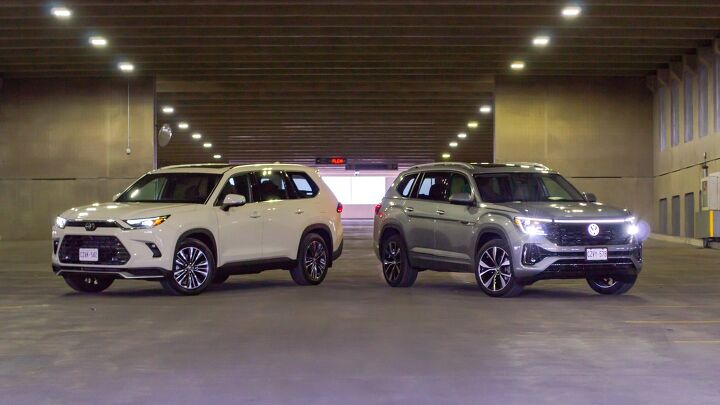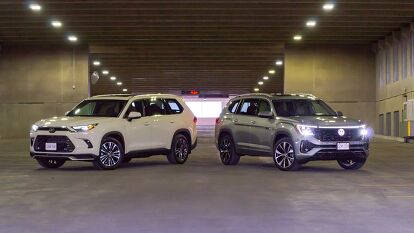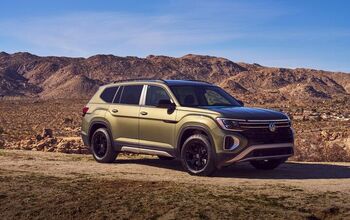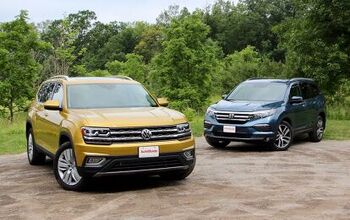Toyota Grand Highlander vs Volkswagen Atlas Comparison

It’s the battle of the big SUVs here—two of the biggest, in fact.
It’s true: outside of the body-on-frame behemoths, not much is larger than the 2024 Toyota Grand Highlander and Volkswagen Atlas. For those who need to haul six or seven people in relative comfort—and are deathly allergic to minivans—these are two of the best. The Toyota is all-new this year, addressing the most common criticism of the non-Grand Highlander: a tight way-back. Meanwhile the Atlas saw a substantial refresh, upping quality while trimming the powertrain options.
Which three-row SUV is the better family hauler option? Managing editor Mike Schlee and I spent a week with both to find out.
Interior and Cargo Space
Toyota Grand Highlander: The Grand Highlander takes cues from the recently introduced Crown for its top-level cabin design—blending them in, naturally, with a heavy dose of existing Highlander. Toyota has skipped the metallic support on the passenger side, which drops the dashboard height for better visibility. A scooped-out center console feels substantial, and not just because there’s a tiny shifter—something these two share. The Grand keeps the useful passenger-side storage slot, but lacks a pass-through center console like the more functional Atlas. The Platinum brings in a handful of smart bronze highlights, however.
The first two rows are incredibly comfortable, happily fitting adults and swaddling them with heated and ventilated thrones. The front bottom cushions are flatter than those in the VW, which could give the German the edge for longer-legged folks. Meanwhile, the Toyota has all-leather armrests for its second-row captain’s chairs. Fancy.
While much has been made about the Grand Highlander’s third row, it’s not as spacious as the Atlas’. There’s less leg- and hip room, and it’s just a darker space. That being said, the GH is vastly better than the original Highlander, and it fits in an extra seat, so it has a passenger count advantage.
These two are neck and neck when it comes to cargo space. Both post the same 20.6 cubic feet (583 liters) behind the way-back, though the Toyota’s is narrower and deeper; better for longer items, worse for shorter people trying to fold the seats. The fold-flat trio in the back opens up a slight advantage when driven in two-row mode (57.9 cubes / 1,640 L). That advantage shrinks to less than a cubic foot with both rows folded down, with a cavernous 97.5 cubes (2,761 L).
Toyota rates the Grand Highlander to a maximum of 5,000 pounds of towing when properly equipped.
Volkswagen Atlas: One of our main criticisms of the outgoing Atlas was an interior that didn’t align with the price tag. Volkswagen has addressed that for 2024, trading up to softer materials and some pretty, adjustable ambient lighting. The combination of light surfaces and gently curved wood give the Atlas cabin a more natural, airy feel. We don’t love the piano black infecting the center console, but we can’t argue with the space for drinks, our phones, and small bags underneath. The VW’s door cubbies are also huge.
Up front, the Atlas has sculpted buckets that keep its driver and front passenger locked in, while providing extra lower leg support. The second row seats are a trade-off over the Toyota: more headroom (40.4 inches / 1,026 millimeters against 38.5 inches / 978 mm) for less legroom (37.6 inches / 955 mm against 39.5 inches / 1,003 mm). The middle row also misses out on the ventilated seats found in the Toyota, but keep heating.
The Atlas' third row remains one of the most comfortable spots for a pair of adults outside of a minivan. Yes, just a pair: VW makes a very conscious decision to keep its big boy down to a duo in the way-back, enhancing the feeling of space. The seat cushions have a good gap from the floor, so knees aren't up by necks. The flat window line also makes it less claustrophobic.
The VW's cargo space is ample. With all seats up it's a Toyota-matching 20.6 cubic feet (583 L). Drop one row of seats and that becomes 55.5 cu ft (1,572 L); drop two and you've got 96.8 cu ft (2,741 L) to build a wicked Hot Wheels track.
Bottom Line: Toyota might have debuted the Grand Highlander specifically to address the tight rear row of the non-Grand, but the Atlas shows there’s still room for improvement there. That said, the VW also only has to seat two out back instead of three. The rest of the space is a closer fight: more comfy front seats for the VW, slightly more spacious seconds for the Toyota. Call it a draw.
Toyota Grand Highlander vs Volkswagen Atlas: Tech and Features
Grand Highlander: Toyota's latest infotainment system takes up residence in a large 12.3-inch screen here. It's super-easy to figure out, with only a handful of main menu buttons on the left. We found the voice assistant had a lower success rate than the German, however. Wirless Apple CarPlay and Android Auto are both available, though at least with the former, there's an unnecessary amount of tile-poking to swap between the native and phone menus. The 11-speaker JBL sound system is inoffensive and unremarkable.
Toyota stuffs plenty of driver and safety assists into every trim of the Grand Highlander. Full-range cruise control with stop and go, lane assists, blind spot monitoring, auto park assist, Traffic Jam assist—it's all here. The Platinum drops in a useful 360-degree camera—which stays active at low speeds—and a slightly less useful user profile face identification feature for the infotainment.
Atlas: While it once left advanced driver assists to the options list, Volkswagen has made big strides in their standardization over recent years. IQ.Drive is part of every Atlas for '24, including adaptive cruise control, blind spot monitoring with rear cross-traffic alert, automated emergency braking, and a safe exit assist. This top trim tester adds such niceties as auto high beams, parking sensors, and a 360-degree camera of its own. Like the Toyota, the Volkswagen also benefits from a power tailgate.
It almost feels like pummelling a deceased equine, but VW's latest 12.0-inch infotainment has issues. Namely, the touch-sensitive (but not illuminated) controls along the bottom edge of the screen. Beyond that, it's only merely frustrating, with some odd menu structures that would become second nature after a few weeks of ownership. But the sliders? Ugh.
The VW does have other tech advantages, however. Its Harman Kardon sound system is better for example, as is its more intuitive voice assistant. I like the wicked-sharp digital instrument panel and its customization options; Mike—or more accurately, Mike's son—gives the adjustable ambient lighting the thumbs up.
Powertrain, Driving Feel, and Efficiency
Grand Highlander: This Grand Highlander comes with the Hybrid Max powertrain, a setup unavailable in the regular Highlander. Don’t let the name fool you: while it can still run on battery power to eke out greater efficiency, this is a performance powertrain first. And boy does it perform.
With 362 horsepower and 400 pound-feet of torque left to motivate 4575 pounds—around 90 less than the Atlas—the Grand Highlander is the comparative grand hotrod. All-wheel drive power comes in without delay, with the thick swell of torque masking the six-speed auto’s lack of available ratios. There’s even a decent (piped-in) sound, giving the GH the rumble of a bigger V6.
While there’s a little more weight and inches between the axles than the regular Highlander, the Grand still rides like a modern TNGA platform vehicle. That is to say it’s tidy, with light and consistent steering. The GH doesn’t feel unwieldy in traffic, helped by clear sightlines and confidence-boosting brakes. I found there to be less wind noise on the highway than in the Atlas.
The EPA rates the Grand Highlander Hybrid Max at 26 mpg city and 27 mpg highway, for a combined 27 mpg rating. (Canadian figures are 9.0, 8.6, and 8.8 L/100 km, respectively). Our weekly consumption was right in line with the official figures.
Atlas: Whereas the Grand Highlander adds more powertrain options, VW refined its numbers down for 2024. The VR6 has been put out to pasture, with only a 2.0-liter turbo remaining. Whether buyers pick front- or all-wheel drive, an eight-speed automatic handles shifting duties. Can something as chonky as the Atlas work with something so tiny?
Absolutely. This is a refined version of VW’s ubiquitous EA888 engine. Now dubbed Evo 4, it’s the same engine found in the mk8 GTI and Golf R, here putting out 269 hp and 273 lb-ft. Mike thinks VW is underquoting, and I’m inclined to agree. The Atlas moves, even with four other people along for the ride. Is it as quick as the Toyota? Nope. But it’s more than adequate for the segment.
While nothing major has happened under the skin, Volkswagen engineers did slightly tweak the suspension to accommodate the new engine. Whatever was done, the result is greater than the sum of its parts, as the Atlas is now a much friendlier vehicle to drive. Older models always felt like they were attempting to simulate body-on-frame SUVs, all lumbering weight transfer and slow responses. This ’24 is clean and composed. It isn’t as fun on the back road home after dropping off the kids, but the Atlas holds its own. The VW will also play a simulated soundtrack, even more dramatic and OTT than the Toyota’s.
One area the VW just can’t hack it is fuel economy. Its ratings of 19 mpg city, 25 mpg highway, and just 21 mpg combined put it mid-pack in the segment and well behind the Toyota. Canadian figures are 12.6, 9.4, and 11.2 L/100 km, respectively.
Bottom Line: No doubt about it, the Toyota has the preferred powertrain here.
Toyota Grand Highlander vs Volkswagen Atlas: Styling
Grand Highlander: Somewhere deep inside Toyota headquarters, there is a machine that spits out SUV designs. I like to think there are a few levers and dials: size, boxiness, aggression, you get the idea. Someone set the first one to “XXL” but forgot to tweak a single other one. The Grand Highlander is default SUV shape writ large. A modern pop song, the sort you forget the moment it stops playing. You will lose the GH in the parking lot. The design is the vehicle’s weakest aspect, with only the chamfered D-pillar getting close to being interesting.
Atlas: This is technically the second facelift for VW’s biggest SUV, but I think it’s a successful one. The flanks are still dominated by swollen fenders, but there are now squarer headlights connected with a thin LED strip atop the grille. So many other brands are doing thin, wide headlights, so I appreciate VW bucking the trend there. The Germans embraced the full-width taillight treatment however, with a thicc bar across the tailgate. Light-up emblems aren’t too gimmicky since they’re reasonably sized; there’s a nice touch here, as the outlined logo signifies an ICE vehicle, while filled-in logos are for EVs. The VW also has the better wheel design.
Bottom Line: These two are big and bulky SUVs; there’s only so much that can be done to that shape, as evidenced by the very similar window lines. We both find the VW the more handsome of the two, but your tastes may vary.
Pricing and Value
Grand Highlander: The Grand Highlander kicks off in the XLE trim, for $44,715 in front-drive format and $46,315 ($52,420 CAD) for AWD. This loaded Platinum Hybrid Max tester exists at the opposite end of the spectrum, ringing in at a spendy $59,870 ($67,380 CAD). There are no options at this level beyond premium paint.
Atlas: The German undercuts its Japanese competitor across the board. The Atlas lineup starts at an attractive $39,420, but you'll need to drop an additional $1,900 for AWD, bringing the cost to $41,320 ($52,045 CAD).
This is also top trim, dubbed SEL Premium R-Line in the US and simply Execline in Canada. Add on the second row captain's chairs ($695 / $700 CAD), and the final tally is $55,010 ($62,745 CAD).
All Grand Highlander and Atlas prices include destination.
Bottom Line: The Toyota is pricier on either side of the border, by precisely $4,860 in the US and $4,635 CAD in Canada. Put another way, a difference of less than 10 percent, and an amount that's all so much easier to swallow in the likelihood of monthly payments.
Toyota Grand Highlander vs Volkswagen Atlas: Verdict
This is one of those comparisons where I was genuinely unsure which vehicle I’d prefer going into it. The Grand Highlander has so many on-paper advantages, while the VW shines in the real world. No wonder it’s such a sales force for VW.
For me, the Toyota just noses ahead. While it’s pricier, we’re talking a small difference in monthly payments, for an extra 100 horsepower and still better fuel economy. The cabin doesn’t feel quite as special as the VW’s but still very nice, and the third row is a wash for me: more seats versus more space. Mike felt otherwise, however.
"For me, the choice between these two vehicles comes down to a right brain versus left brain dilemma," explains Schlee. "Looking at all the reasons Kyle mentioned, the Grand Highlander is the more sensible vehicle to purchase. It has more power, better efficiency, and still a wholly usable interior."
"But I enjoy being in the Volkswagen Atlas more. It’s completely subjective in reasoning, but the interior, driving feel, and layout just speaks to me more than the Grand Highlander. The Toyota is a great tool for transporting larger quantities of people in premium comfort, but if I’m in the market, the Volkswagen would probably get my dollars."
Become an AutoGuide insider. Get the latest from the automotive world first by subscribing to our newsletter here.

Kyle began his automotive obsession before he even started school, courtesy of a remote control Porsche and various LEGO sets. He later studied advertising and graphic design at Humber College, which led him to writing about cars (both real and digital). He is now a proud member of the Automobile Journalists Association of Canada (AJAC), where he was the Journalist of the Year runner-up for 2021.
More by Kyle Patrick







































































































Comments
Join the conversation
I brought a 2018 VW and vr6. It has 140k + miles. Zero issues!! I can tell you I'm getting avg 26mpg. Hate the idea of losing the V6.
We recently purchased a VR6 2023 Atlas Exculine R. We had a Murano Platium before and cannot believe the up grade this made to our travel enjoyment. What a great vehicle.